Radeon RX Vega Unveiled: AMD Announces $499 RX Vega 64 & $399 RX Vega 56, Launching August 14th
by Ryan Smith on July 30, 2017 10:30 PM EST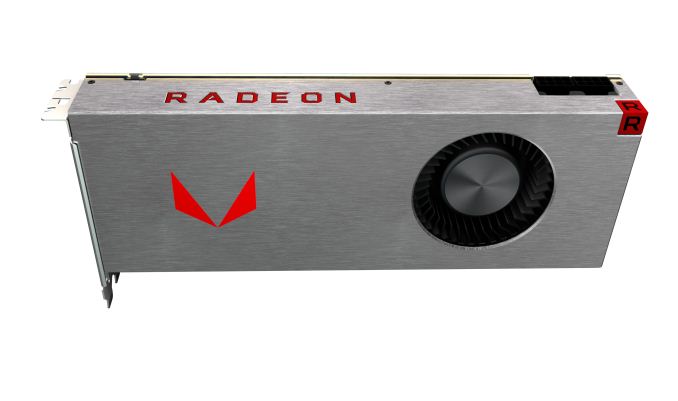
At this point, one must give credit to AMD for their marketing program for the Radeon RX Vega. The company has opted to drip feed information over many months, and as a result this has kept the public interested in the architecture and consumer RX Vega cards. Since it was by name back in the spring of 2016, we’ve had architecture previews, product teasers, and even a new Frontier Editions to tide us over. Suffice it to say, there’s a great deal of fascination in finally seeing the products AMD has been beating the drums about for so long.
To that end, there’s good news today and there’s bad news today. In the interest of expediency, I may as well start with the bad news: today is not the launch day for the Radeon RX Vega. In fact, only right before this embargo expired did AMD even announce a launch date: August 14th. So for reviews, performance analyses, and of course purchasing, everyone will have to hold on just a bit longer.
The good news then is that even if today isn’t the Radeon RX Vega launch, AMD is finally making significant progress towards it by announcing the cards, the specifications, and the pricing. Gamers may not be able to buy the cards quite yet, but everyone is going to have some time to size up the situation before the proper launch of the cards next month. Overall this situation is very similar to the unveiling of the Radeon R9 290 series, where AMD announced the cards at a product showcase before launching them the following month.
So without further ado, let’s dive into the Radeon RX Vega family of cards and their specifications.
| AMD Radeon RX Series Specification Comparison | ||||||
| AMD Radeon RX Vega 64 Liquid | AMD Radeon RX Vega 64 | AMD Radeon RX Vega 56 | AMD Radeon R9 Fury X | |||
| Stream Processors | 4096 (64 CUs) |
4096 (64 CUs) |
3585 (56 CUs) |
4096 (64 CUs) |
||
| Texture Units | 256 | 256 | 224 | 256 | ||
| ROPs | 64 | 64 | 64? | 64 | ||
| Base Clock | 1406MHz | 1247MHz | 1156MHz | N/A | ||
| Boost Clock | 1677MHz | 1546MHz | 1471MHz | 1050MHz | ||
| Memory Clock | 1.89Gbps HBM2 | 1.89Gbps HBM2 | 1.6Gbps HBM2 | 1Gbps HBM | ||
| Memory Bus Width | 2048-bit | 2048-bit | 2048-bit | 4096-bit | ||
| VRAM | 8GB | 8GB | 8GB | 4GB | ||
| Transistor Count | 12.5B | 12.5B | 12.5B | 8.9B | ||
| Board Power | 345W | 295W | 210W | 275W (Typical) |
||
| Manufacturing Process | GloFo 14nm | GloFo 14nm | GloFo 14nm | TSMC 28nm | ||
| Architecture | GCN 5 | GCN 5 | GCN 5 | GCN 3 | ||
| GPU | Vega 10 | Vega 10 | Vega 10 | Fiji | ||
| Launch Date | 08/14/2017 | 08/14/2017 | 08/14/2017 | 06/24/2015 | ||
| Launch Price | $699* | $499/599* | $399/499* | $649 | ||
All told, AMD will be releasing 3 different RX Vega cards. All 3 cards are based on the same GPU, Vega 10, which powers the already released Radeon Vega Frontier Edition. So if you’re familiar with that card, then you should have an idea of what to expect here.
The top of AMD’s lineup is the Radeon RX Vega 64 Liquid Cooled Edition. This is a fully enabled Vega 10 card and it has the highest clockspeeds and highest power requirements of the stack. All told, this is 64 CUs, 64 ROPs, boosting to 1677MHz, and paired with 8GB of HBM2 memory clocked at 1.89Gbps. Typical board power for the card is rated at 345W. To cool such a card, you of course will want liquid cooling, and living up to the name the card, AMD has included just that, thanks to a pump and 120mm radiator.
The second member of AMD’s lineup is the shorter-named vanilla Radeon RX Vega 64. Unlike its liquid cooled predecessor, this is a traditional blower-type air cooled card. And for the purposes of AMD’s product stack, the company is treating the vanilla Vega 64 as the “baseline” card for the Vega 64 family. This means that the company’s performance projections are based on this card, and not the higher-clocked liquid cooled card.
The vanilla Vega 64 utilizes the same fully enabled Vega 10 GPU, with 64 CUs and 64 ROPs. The card’s reduced cooling capacity goes hand-in-hand with slightly lower clockspeeds of 1247MHz base and 1546MHz boost. Paired up with the Vega GPU itself is the same 8GB of HBM2 as on the liquid cooled card, still running at 1.89Gbps for 484GB/sec of memory bandwidth. Finally, this card ships with a notably lower TBP than the liquid cooled card, bringing it down by 50W to 295W.
Meanwhile, unlike any of the other cards in the RX Vega family, the Vega 64 will come in two shroud design options. AMD’s reference shroud is a plastic/rubber design similar to what we saw on the reference Radeon RX 480 launched last year. AMD will also have a “limited edition” version of the card with the same hardware specifications, but replacing the rubber shroud with a brushed aluminum shroud, very similar to the one found on the Vega Frontier Edition. Though it’s important to note that the only difference between these two cards is the material of the shroud; the cards are otherwise identical, PCBs, performance, cooling systems, and all.
On that note, AMD has only released a limited amount of information on the cooler design of the Vega 64, which is of particular interest as it’s an area where AMD struggled on the R9 290 and RX 480 series. We do know that the radial fan is larger, now measuring 30mm in radius (60mm in diameter). The fan in turn is responsible for cooling a heatsink that’s attached to the Vega 10 GPU + memory package via a vapor chamber, a typical design choice for high performance, high TDP video cards.
Finally, the last member of the RX Vega family is the Radeon RX Vega 56. The obligatory cut-down member of the group, this card gets a partially disabled version of the Vega 10 GPU with only 56 of 64 CUs enabled. On the clockspeed front, this card also sees reduced GPU and memory clockspeeds; the GPU runs at 1156MHz base and 1471MHz boost, while the HBM2 memory runs at 1.6Gbps (for 410GB/sec of memory bandwidth). Following the traditional cut-down card model, this lower performing card is also lower power – and quite possibly the most power efficient RX Vega card – with a 210W TDP, some 85W below the Vega 64. Meanwhile, other than its clockspeed the card’s HBM2 memory is untouched, shipping with the same 8GB of memory as the other RX Vega members.
Moving on, perhaps the burning question for many readers now that they have the specifications in hand is expected performance, and this is something of a murky area. AMD has published some performance slides for the Vega 64, but they haven’t taken the time to extensively catalog what they see as the competition for the card and where the RX Vega family fits into that. Instead, what we’ve been told is to expect the Vega 64 to “trade blows” with NVIDIA’s GeForce GTX 1080.
In terms of numbers, the few numbers that the company has published have focused on minimum framerates over average framerates, opting to emphasize smoothness and the advantage they believe to have over the aforementioned GTX 1080. As always, competitive numbers should be taken with a (large) grain of salt, but for the time being this is the best guidance we have on what to expect for the RX Vega family’s performance.
Otherwise for the Vega 64 Liquid and Vega 56, we don’t have any other performance figures. Expect the former to outperform the air cooled Vega 64 – though perhaps not massively – while the Vega 56 will come in notably lower.


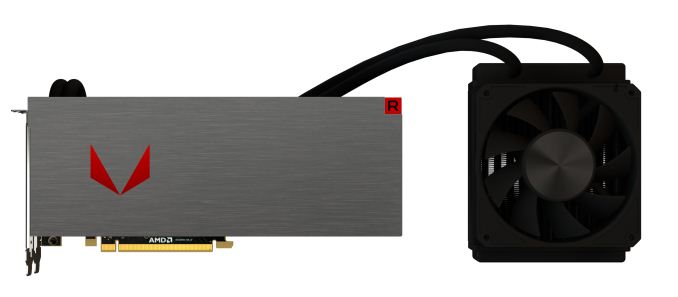
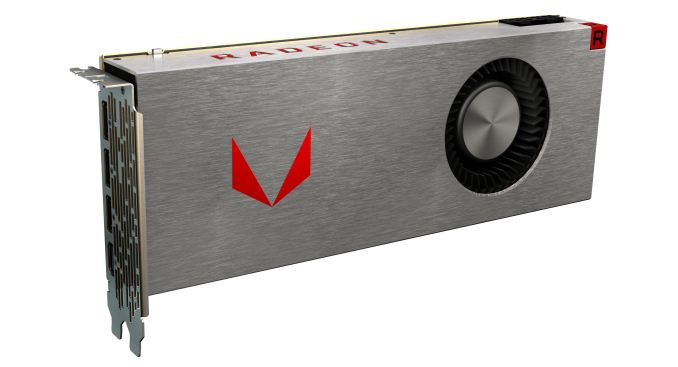

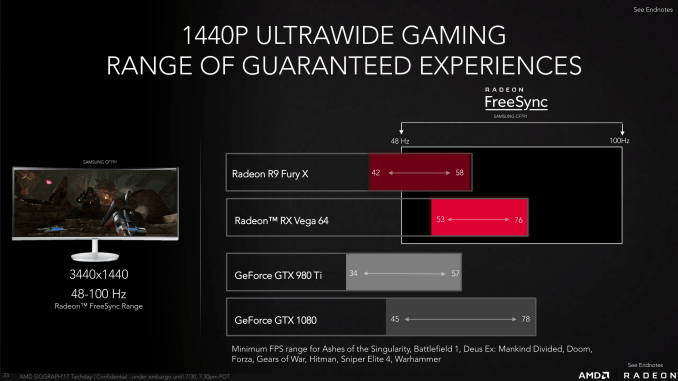
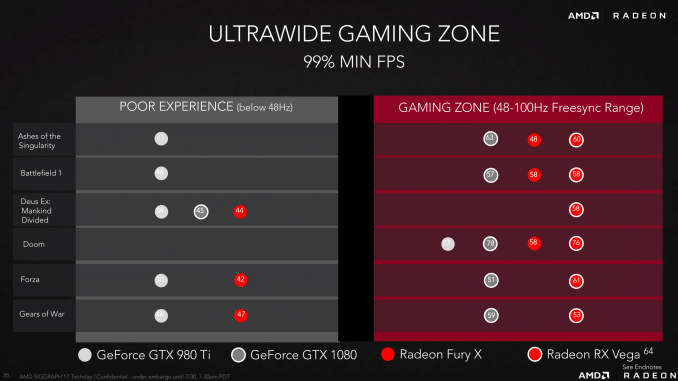








162 Comments
View All Comments
Kjella - Monday, July 31, 2017 - link
I bought the 1800X too, if they'd have spilled the beans on Threadripper a little earlier I might have waited for that. Vega? Sorry I smelled that hype train far away, think it scared nVidia a bit though because I think they saw Zen and thought AMD is on fire let's secure sales while we can because the 1080Ti for $700 carried an extremely small premium to be the top card. AMD releasing a card trading blows with the 1080 at 300W+ five months later? My guess someone at nVidia is kicking themselves for not making it an $8-900 card. "Only" 250W on air, 11GB RAM, HDMI 2.0b/DisplayPort 1.4 out and usable framerates at 4K without SLI and the long lifetime of DX12/Vulkan makes me think it's an investment I don't want to replace any time soon. It's probably an okay value card to keep AMD in the loop, but nothing more. Hopefully Threadripper and EPYC will keep them floating to come up with something better.lordken - Monday, July 31, 2017 - link
what does ryzen has anything to do with Vega (PR) failure?Nobody doubt ryzen (except hardcore intel fanboys), ryzen/tr/epyc all looks great and ryzen is on my list for upgrade.
Jimster480 - Monday, July 31, 2017 - link
The main problem is the number of ROPs.It was the problem in the Fury and it will be the problem here.
If they want more FPS they need to add more ROPs.
Ej24 - Monday, July 31, 2017 - link
Yeah it's strange, their entire gpu pipeline is massively wide except the rops on the backend. They're always rop starved.bug77 - Monday, July 31, 2017 - link
Yet I have it from one of their own engineers that they have no indication of any ROP bottleneck. Go figure...vladx - Monday, July 31, 2017 - link
And Raja told me himself that's not true... See how easy that is?Lord of the Bored - Tuesday, August 1, 2017 - link
They could make the second longer. And raise the speed of light while they're at it.extide - Monday, August 14, 2017 - link
It's not the ROP's. Fiji always killed it in fillrate tests, which basically test the ROP's. In Fiji, at least the main bottleneck was the Geometry engines.guidryp - Monday, July 31, 2017 - link
It is exactly that they tried to put lipstick on a pig that so pisses me off.vladx - Monday, July 31, 2017 - link
"It is exactly that they tried to put lipstick on a pig that so pisses me off."It's not like it's something new to AMD, they've being doing this overhyping thing for ages.